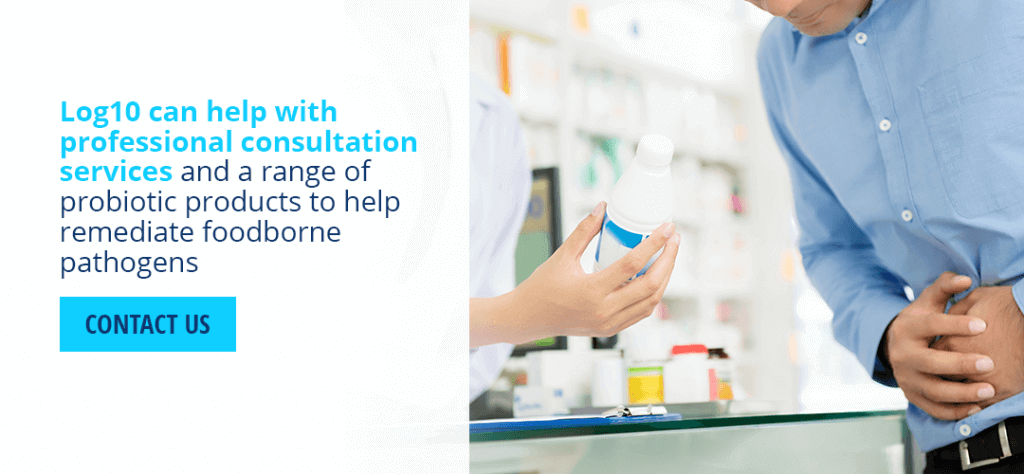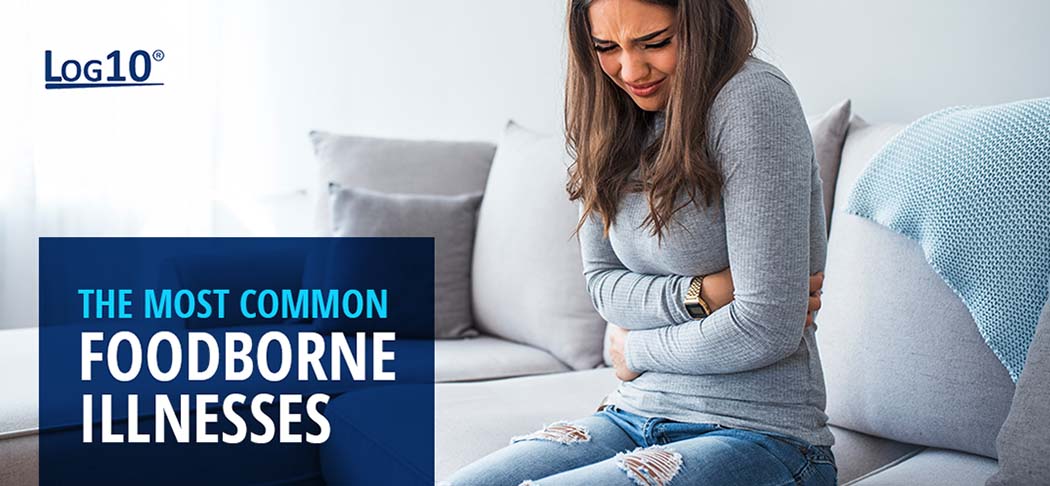
As the food industry continues to expand to meet the needs of an ever-growing population, food safety is a growing concern among producers and consumers alike. Foodborne illnesses are still a substantial problem within the industry, with an average of one in six Americans experiencing food-related diseases per year. People who contract these illnesses can experience severe gastrointestinal pain and disruption, as well as joint pain, nausea, fever and fatigue. In the most severe cases, people can even die from common foodborne illnesses — the Centers for Disease Control estimate about 3,000 Americans die each year from foodborne illness.
With foodborne illnesses affecting over 48 million people each year and costing the U.S. over $15 billion a year in losses, foodborne illnesses are a problem producers cannot underestimate. That is why it is essential for food production companies to be aware of the common foodborne illnesses affecting their industry and consumers and how to handle them appropriately.
In This Article:
- Causes of Most Common Foodborne Illnesses
- Categories of Food Pathogens
- Top Foodborne Illnesses
- How to Prevent Foodborne Illnesses at Your Facility
Causes of Most Common Foodborne Illnesses
Foodborne illnesses occur as a result of consuming contaminated foods or beverages. The contaminant itself varies, but typically falls into one of the following categories.
- Biological hazards: Biological hazards can include bacteria, viruses or parasites, and account for the majority of foodborne illnesses. Most biological hazards occur due to improper handling or processing of food — for example, a food handler could transfer bacteria from their hands to the food by not wearing gloves or failing to wash their hands. Another common source of biological hazards is the food itself. If an animal is carrying a virus at the time of death, that virus can carry over from its meat and transfer to the consumer.
- Chemical hazards: Chemical hazards are both natural and unnatural toxins and contaminants in food. Some toxins come from the food source either naturally or due to mishandling — for instance, some types of seafood produce toxic levels of histamine when they sit out too long or reach an unsafe temperature. Contamination is the other source of chemical hazards, and occurs due to the improper application of additives or cleaning solutions. Allergens are another example of chemical hazard. In these cases, people who are sensitive to certain proteins may experience allergic reactions if their food gets contaminated with those proteins.
- Physical Hazards: Physical hazards are non-edible contaminants in food that can cut or tear the consumer when eaten. Some examples include metal shavings from cans or pieces of broken plastic or glass.
Foodborne Illness Pathogens
Biological hazards are the most common causes of foodborne illnesses and come from a wide variety of pathogens. To date, food researchers have identified over 250 different foodborne diseases, and the list continues to grow. These food pathogens fall under one of the following groups.
- Bacteria: Bacteria are single-celled organisms that multiply through cell division. Bacterial growth relies on the appropriate environmental conditions, including the nutrients, moisture levels, acidity, temperature and availability of oxygen. Different types of bacteria require different resource levels to grow, but most will grow best between 41 and 140 degrees Fahrenheit.
- Molds: Molds are multicellular fungi that reproduce through spores. Mold spores grow well in damp, dark environments, sending roots into their food source for nourishment. While some molds are relatively harmless, others can produce toxins that can cause illness.
- Viruses: Viruses are the smallest known organisms, though it is debatable whether they are “alive” or not. Viruses need hosts to reproduce — they infect host cells and reprogram them to produce new viruses. Viral infections often cause disease, though the severity of the disease varies based on the virus in question. Infected people often transmit viruses to food.
- Parasites: Parasites are multicellular organisms that live within a host. These parasites include worms and protozoa, and rely on a host cell to reproduce and grow.
Common Food Borne Illnesses
The big six food pathogens.
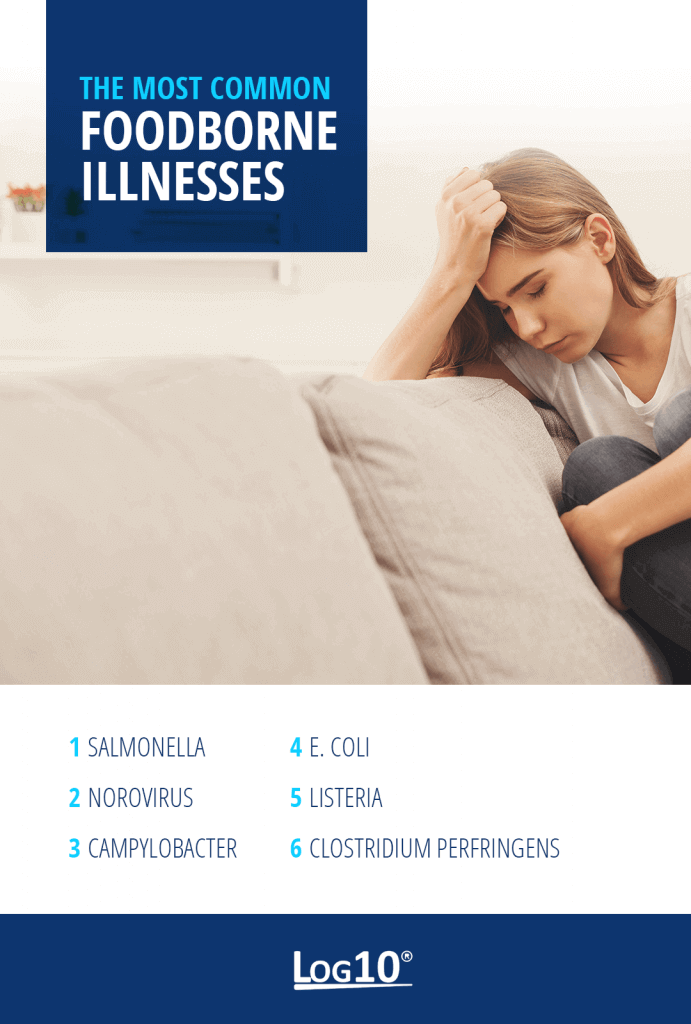
While you may see them grouped into general categories, the severity of a foodborne illness depends on the type of bacteria or virus contaminating the food, as well as the susceptibility of the consumer. Below are the most common examples of common foodborne illnesses that pose a widespread threat — while they vary in severity from a health standpoint, the negative effects of each disease are substantial to both consumers and food production companies.
1. Salmonella
Salmonella is one of the top foodborne illnesses. This group of bacteria is common in raw food products from animals, including eggs, meat, milk and related products. Additionally, fresh produce can be contaminated with salmonella if it comes into contact with animals carrying the disease.
If a person consumes a product contaminated with salmonella, symptoms can start between 12 and 72 hours after infection. These symptoms include fever, vomiting, abdominal cramps and diarrhea. Hospitalization is sometimes required for those with severe diarrhea, as these individuals may be at risk for the infection spreading. Treatment usually includes antibiotics and increased fluid intake.
While healthy adults will typically recover from the pathogen in four to seven days, at-risk populations like children, the elderly and those with compromised immune systems may develop more severe conditions and experience complications. The CDC estimates salmonella causes about 1.2 million illnesses, 23,000 hospitalizations and 450 deaths annually in the United States. Of these illnesses, contaminated food is the source of about 1 million cases.
Prevention of salmonella outbreaks requires food treatment with specialized probiotics such as Log10’s Pre-Liminate™ probiotic blends. These custom blends can remediate salmonella in food products regardless of the presence of biofilms.
2. Norovirus
If you’ve encountered the stomach flu, you’ve likely had norovirus. Also known as the Norwalk virus, norovirus is a highly contagious virus and is the leading cause of illness and outbreaks from contaminated foods. When contracted from other infected individuals, contaminated water or even surfaces carrying the disease, this virus spreads quickly and can infect anyone.
Symptoms of norovirus typically develop 12 to 48 hours after infection and include stomach pain, nausea, vomiting and diarrhea. Other, less common, symptoms include fever, headache and body aches. In extreme cases, an individual may develop dehydration leading to hospitalization. Healthy individuals will usually get better within one to three days, though children, older adults and immunocompromised individuals may experience more complications.
Prevention of norovirus is difficult due to its extremely contagious nature, but there are steps food handlers can take to prevent outbreaks. Enforcing proper handwashing techniques, cleaning equipment thoroughly and ensuring proper preparation of food are straightforward, yet effective, ways to combat norovirus.
3. Campylobacter
Campylobacter is a bacterium that causes an infectious disease called campylobacteriosis. This bacterium is one of the most common causes of diarrheal illness in the United States, with an estimated 1.3 million people affected each year. Infections often spread through contaminated food or water, undercooked meat, raw milk or contact with farm animals.
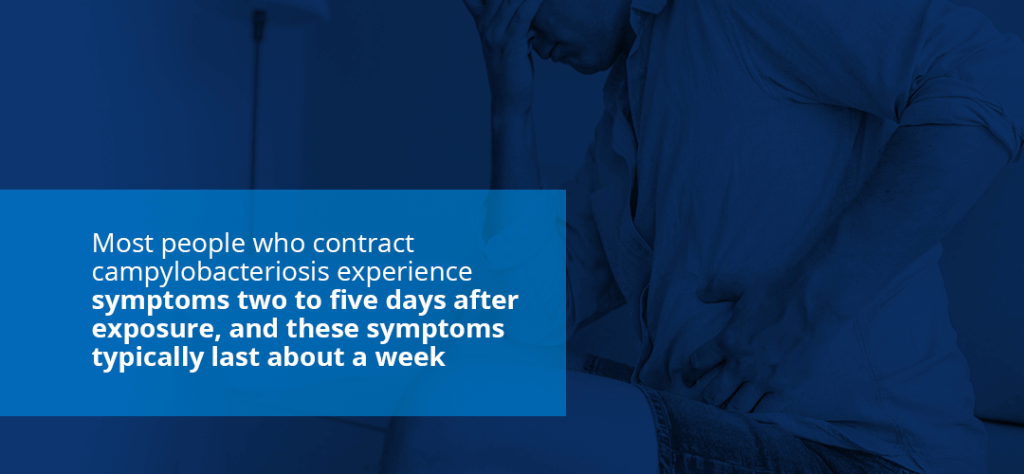
Most people who contract campylobacteriosis experience symptoms two to five days after exposure, and these symptoms typically last about a week. Symptoms include cramping, abdominal pain, fever and diarrhea. In some cases, diarrhea may be bloody, and people may encounter nausea and vomiting on top of the typical symptoms. While some healthy individuals don’t encounter any symptoms, children under 5, the elderly and immunocompromised individuals may experience complications. Campylobacter can spread to the bloodstream to cause a life-threatening infection. In approximately one in 1,000 cases, a campylobacter infection may lead to Guillain-Barré syndrome, which can cause long-term weakness or paralysis.
Proper handwashing practices can prevent the spread of campylobacter, as well as thorough cleaning of food prep areas and cooking meats to safe temperatures.
4. E. Coli
Escherichia coli, more popularly known as E. coli, is another common foodborne illness. This large and diverse group of bacteria includes both harmless and pathogenic strains that live in the intestines of humans and animals. E. coli often gets transmitted through contaminated water or food or through contact with infected animals or people.
There are six harmful types of E. coli, but the most commonly discussed one is Shiga toxin-producing E. coli, or STEC. Also referred to as verocytotoxin-producing E. coli or enterohemorrhagic E. coli, this pathogen is most commonly associated with large outbreaks and is usually the one reported in the news. Symptoms of STEC infections vary, but often include stomach cramps, diarrhea and vomiting. Kidney failure is a frequent side-effect of the infection. Most cases of STEC infections are mild, but can be severe or life-threatening, especially for at-risk populations. Unless complications occur, many people recover from E. coli-related illnesses within eight days.
Prevention of E. coli outbreaks requires consistent cleaning and hygiene routines, but food processors can take an extra step to prevent E. coli through probiotic treatments. Log10 Pre-Liminate™ custom probiotic blends can help remediate contamination in food, improving food safety for consumers and processing facilities alike.
5. Listeria
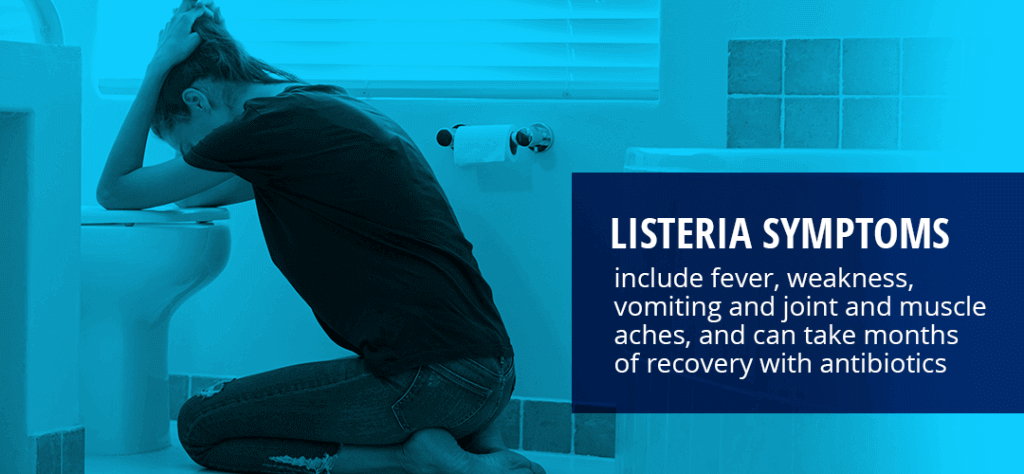
Listeria monocytogenes, also known as L. monocytogenes, is a highly resilient bacterium that causes an infection called listeriosis. This bacteria is common in water, soil and farm animals like chickens and cattle. Listeria is a particularly problematic pathogen for food processing facilities, as it is capable of growing in colder temperatures, making refrigeration ineffective at stopping it.
Listeriosis is an invasive disease, with symptoms starting one to four weeks after eating contaminated food, though some have reported symptoms starting up to 70 days after exposure. Symptoms include fever, weakness, vomiting and joint and muscle aches, and can take months of recovery with antibiotics. In pregnant women, symptoms are less severe for the woman, but potentially lethal for the fetus — listeria infections during pregnancy can result in miscarriage, stillbirth, premature delivery or life-threatening infections in newborns. In non-pregnant women, symptoms can be more severe — vertigo, confusion and convulsions can occur. The CDC estimates 1,600 people get listeriosis each year, and 260 die from the disease.
Food production companies need to take proactive steps to prevent listeria. Log10 can help with our custom formulated Pre-Liminate™ probiotic blends, which are designed to remediate potential food contamination. On top of thorough cleaning procedures and food safety practices, our probiotic blends can effectively complement your company’s environment to combat listeria outbreaks.
6. Clostridium Perfringens
Clostridium perfringens, or C. perfringens, is a spore-forming bacteria found in many environmental sources as well as human and animal intestines. It does not require oxygen in its environment and can multiply rapidly in ideal conditions. This bacteria is common on raw meat and poultry, as well as gravies, dried foods and pre-cooked foods. C. perfringens infections often occur in environments that prepare food in large quantities and keep it warm for long periods before serving. Hospitals, school cafeterias, prisons, nursing homes and catered events are common sources of outbreaks.
Symptoms of C. perfringens food poisoning tend to begin six to 24 hours after infection, and tend to last for less than 24 hours. The most common symptoms are diarrhea and abdominal cramps, but usually do not include vomiting or fever. For at-risk populations including children and the elderly, symptoms can be more severe, lasting for up to two weeks and leading to complications like dehydration.
C. perfringens can survive very high temperatures, so treating this bacterium properly is essential for public health. Log10 can help with custom-formulated Pre-Liminate™ probiotic blends, which can prevent outbreaks like these.
How to Prevent Foodborne Illnesses at Your Facility
There are numerous other foodborne illnesses outside of those listed above, and food industry companies need to be ready to handle them all. By taking the following steps, your company can help prevent outbreaks.
- Emphasize food safety training: Food safety training should be ongoing at every level of the food industry. Employees should regularly go over food safety practices and be aware of the risks associated with lax food safety protocols. Additionally, company management should assess employees regularly, and keep training material updated to reflect the most recent food safety information and procedures in your company.
- Maintain clean environments: From loading docks to prep stations to packaging facilities, clean and secure facilities are essential for preventing contamination from dirt, debris and unprocessed materials. Pets and traffic should not be able to enter the facility to minimize potential sources of infection, and you should clean and sanitize all surfaces and equipment regularly. Best practices usually include sanitation schedules and daily cleaning routines.
- Enforce good employee hygiene: Handwashing, appropriate clothing and protective equipment, as well as glove-changing protocols, are all essential to minimize cross-contamination.
- Analyze production procedures: Food production facilities should regularly review their procedures and use validation and verification studies to ensure their processes are producing reliably safe results. In these cases, it is always best to base studies on worst-case scenarios to ensure you are producing safe food, regardless of problems that occur during the process.
- Establish testing, prevention and control plans: Planning for the worst is the best way to get results. Set up regular testing schedules and prevention practices to ensure your facility is free of harmful bacteria. Additionally, establish a control plan in case you find harmful bacteria — make sure employees know how to recognize and report potential hazards immediately, and establish an action plan all employees are aware of to handle the situation as quickly as possible.
- Choose quality vendors: Only work with vendors you trust — contaminated raw materials increase the risk of contamination, regardless of how thorough the processing procedures are at your facility.
- Explore effective treatment options: No matter how thorough your prevention practices, pathogens like listeria and salmonella can still pose a danger to your facility. That’s why it is essential to find treatment options with proven solutions, like Log10’s Pre-Liminate™ probiotic blends. This effective proprietary blend is a solution for pathogen inhibition, helping remediate infections regardless of biofilms.
Contact Log 10 for support today!
Contact Log10 to Learn More About Foodborne Illness Prevention
As a produce grower or processor, you know how important it is to maintain food safety practices. Log10 can help with professional consultation services and a range of probiotic products to help remediate foodborne pathogens. Our experienced team uses years of collective food safety experience to deliver results for your facility.
Interested in learning more about our services? Contact Log10 today to see how we can help your business combat food pathogens in your facility.

